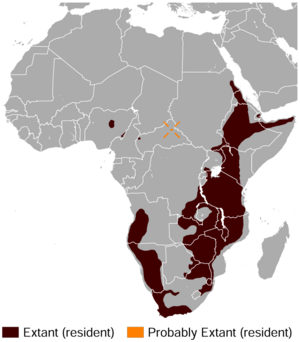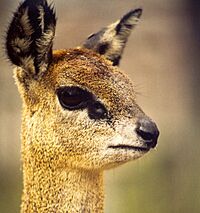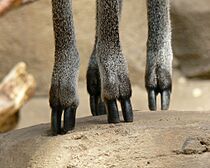Klipspringer facts for kids
Quick facts for kids Klipspringer |
|
|---|---|
 |
|
| Conservation status | |
| Scientific classification | |
| Subspecies | |
|
See text |
|
 |
|
| Klipspringer range | |
| Synonyms | |
|
List
O. cunenensis Zukowsky, 1924
O. hyatti Hinton, 1921 O. klippspringer (Daudin, 1802) O. saltator (Boddaert, 1785) O. saltatricoides Neumann, 1902 O. saltatrixoides (Temminck, 1853) O. steinhardti Zukowsky, 1924 O. typicus A. Smith, 1834 |
The klipspringer (pronounced clip-spring-er) is a small antelope. You can find it in rocky areas of eastern and southern Africa. This amazing animal is the only member of its group, and it was first described by a German zoologist in 1783.
Klipspringers are small but strong. They stand about 43 to 60 centimeters (17 to 24 inches) tall at the shoulder. They weigh from 8 to 18 kilograms (18 to 40 pounds). Their coat is yellowish-gray to reddish-brown. This color helps them blend in perfectly with their rocky homes. Unlike most other antelopes, the klipspringer has a thick, rough coat. Its hairs are hollow and break easily. The males have short, spiky horns, usually about 7.5 to 9 centimeters (3 to 3.5 inches) long.
Klipspringers are often active at night. They rest during the middle of the day and late at night. These animals are very social. They are much more monogamous than other antelopes. This means a male and female often stay together for life. They usually stay within 5 meters (16 feet) of each other. Males create special areas called territories. These can be from 7.5 to 49 hectares (18.5 to 121 acres) in size. They live there with their partners and young. Klipspringers mostly eat plants, fruits, and flowers. A baby klipspringer is born after about six months. The calf leaves its mother when it is about one year old.
Klipspringers live in places with lots of rocks and not much plant life. Their home stretches from northeastern Sudan and Ethiopia in the east. It goes all the way to South Africa in the south. You can also find them along the coasts of Angola and Namibia. The International Union for Conservation of Nature (IUCN) says the klipspringer is of Least Concern. This means it is not currently in danger. Their rocky homes are hard for hunters to reach. Many klipspringers also live on private farms. About 25% of them live in protected areas.
Contents
What's in a Name? Klipspringer's Story
The scientific name for the klipspringer is Oreotragus oreotragus. This name comes from Greek words. Óros means "mountain" and trágos means "he-goat." So, it's like "mountain goat." It's the only animal in its group, called Oreotragus. This species was first described by a German scientist named Eberhard August Wilhelm von Zimmermann in 1783.
The common name "klipspringer" comes from the Afrikaans language. Klip means "rock" and springer means "leaper." So, it literally means "rock leaper." Another name for this antelope is "klipbok."
Scientists have found that the klipspringer is related to other small antelopes. These include Kirk's dik-dik and the suni. The klipspringer first appeared about 14 million years ago. There are different types of klipspringers, called subspecies. They can look a bit different depending on where they live. For example, some have golden yellow coats, while others are more reddish.
Klipspringer's Unique Look
The klipspringer is a small, strong antelope. It stands about 43 to 60 centimeters (17 to 24 inches) tall at the shoulder. Its body length is usually between 75 and 115 centimeters (30 and 45 inches). It weighs from 8 to 18 kilograms (18 to 40 pounds). Female klipspringers are a little bigger and heavier than males. Their tail is short, about 6.5 to 10.5 centimeters (2.5 to 4 inches) long.
They have some special features on their face. These include a brown forehead and short ears with black marks. They also have special glands near their eyes and white lips and chin. Only male klipspringers have horns. These horns are short and spiky, usually 7.5 to 9 centimeters (3 to 3.5 inches) long. The longest horn ever recorded was 15.9 centimeters (6.25 inches).
The klipspringer's coat is yellowish-gray to reddish-brown. This color helps it hide very well in its rocky home. Its belly is white. Unlike most other antelopes, the klipspringer has a thick, rough coat. Its hairs are hollow and break easily. This special coat helps the animal survive falls. It also keeps them warm or cool in the extreme mountain weather. Ticks tend to gather on their softer belly hair. Their hair can stand up, especially if the animal is sick or too warm.
Another unique thing about the klipspringer is how it walks. It walks on the very tips of its round, blunt hooves. This gives them a great grip on rocks. It helps them climb and jump easily over rocky places. Different types of klipspringers have different coat colors. Some are golden yellow, while others are more reddish.
Life in the Wild: Klipspringer Habits
Klipspringers are usually nocturnal, meaning they are active mostly at night. They rest during the middle of the day and late at night. They are more active on nights when the moon is bright. In the morning, they like to sunbathe to warm up. Klipspringers are very social animals. Like dik-diks, they are very monogamous. This means a male and female form a pair that often lasts their whole lives.
The partners usually stay within 5 meters (16 feet) of each other. For example, they take turns watching for predators while the other eats. They face any danger together. If there's danger, the klipspringer will hop a few meters away. Other klipspringer groups include small family herds of eight or more. Sometimes, you might see a klipspringer by itself. When klipspringers meet, they rub cheeks to greet each other.
Male klipspringers create special areas called territories. These areas can be from 7.5 to 49 hectares (18.5 to 121 acres) in size. The size depends on how much rain there is. They live in these territories with their partners and young. Males are usually more watchful than females. Klipspringers make large piles of dung, about 1 meter (3 feet) across and 10 centimeters (4 inches) deep. They place these piles at the edges of their territories. They also mark their territory by rubbing a thick, black substance from glands near their eyes onto plants and rocks.
The main sound they make is a loud whistle. A klipspringer pair will often whistle together. This helps them communicate or warn each other about danger. Animals that hunt klipspringers include baboons, leopards, and different types of eagles. Some birds, like familiar chats, have been seen eating ticks off klipspringers.
What Klipspringers Eat
Klipspringers are mostly browsers. This means they prefer to eat young plants, fruits, and flowers. They eat some grasses, but mostly in the wet season. They get most of their water from juicy plants. They don't usually need to drink from water sources. They can stand on their back legs to reach branches up to 1.2 meters (4 feet) high. Some klipspringers in Namibia have even been seen climbing trees up to 5.4 meters (17.7 feet) high!
Reproduction and Life Cycle
Klipspringers breed at certain times of the year. When they mate depends on where they live. Females can have babies when they are about one year old. Males take a little longer to mature. We don't know much about their mating behavior. A mother klipspringer is pregnant for about six months. After that, she gives birth to one calf. The baby weighs a little more than 1 kilogram (2.2 pounds). Most births happen from spring to early summer.
Newborns are hidden carefully in thick plants for up to three months. This keeps them safe from predators. The mother feeds her baby three to four times a day. Her visits get longer as the baby grows. Male klipspringers protect their young. They watch out for other males and predators. The calf stops drinking milk at four to five months old. It leaves its mother when it turns one year old. Klipspringers can live for about 15 years.
Where Klipspringers Live
Klipspringers live in places with lots of rocks and not much plant life. If food becomes scarce, they might move to lower areas. You can find klipspringers at very high altitudes, even up to 4,500 meters (14,760 feet) on Mount Kilimanjaro. In some good habitats, there can be many klipspringers. For example, 10 to 14 klipspringers can live in one square kilometer in Simien Mountains National Park in Ethiopia. However, their rocky homes are often spread out. So, usually, there are only about 0.01 to 0.1 klipspringer per square kilometer.
These antelopes live in large numbers across eastern and southern Africa. Their range goes from northeastern Sudan, Eritrea, northern Somalia, and Ethiopia in the east. It stretches all the way to South Africa in the south. They also live along the coasts of Angola and Namibia. Smaller groups can be found in the highlands of the Central African Republic. They are also in southeastern Democratic Republic of Congo and parts of Nigeria. Sadly, they might no longer exist in Burundi.
Klipspringer Conservation
The International Union for Conservation of Nature (IUCN) says the klipspringer is of Least Concern. This means they are not currently in danger of disappearing. People sometimes hunt klipspringers for their meat, leather, and hair. However, there are no major threats to their survival. This is because their rocky homes are hard to reach and not good for hunting. Also, klipspringers don't have to compete with farm animals for food. Farm animals usually don't go into mountain areas. But klipspringers living in lower areas are more at risk.
In 1999, experts estimated there were about 42,000 klipspringers in total. Many of them live on private farms. As of 2008, about 25% of klipspringers live in protected areas. These include national parks like Simien Mountains National Park in Ethiopia and Tsavo East National Park in Kenya. They also live in parks in Zambia, Malawi, Namibia, and Zimbabwe.







